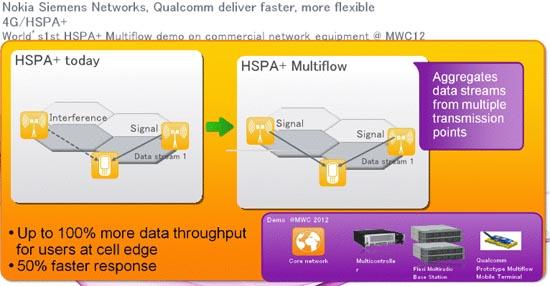
There will be plenty of companies showing off their wares at Mobile World Congress later this month, and today Nokia Siemens Networks announced what it has up its sleeve for the big show. Called HSPA+ Multiflow, the technology allows devices to connect to two separate HSPA+ cell sites at the same time. The purpose is to allow a phone or other product that's on the edge of one cell site to connect to a second neighboring cell at the same time. The data being transmitted to the device then has two different paths it can take, and Nokia Siemens Networks says that using Multiflow can result in up to double the data speeds and 50 percent faster response times compared to current HSPA+ networks. Carriers will be able to update their existing Nokia Siemens Networks HSPA equipment to support Multiflow with a software upgrade, but our devices will need new hardware to take advantage of the tech.
Nokia Siemens Networks says that HSPA+ Multiflow will be shown off at MWC using Qualcomm USB dongles. The company expects Multiflow to be standardized by the 3GPP by the middle of 2012, with commercial availability expected by the second half of 2013.
Sounds pretty cool, no? It's always good to hear when about new tech that's aimed at helping folks in the fringe coverage of cell sites, and if Multiflow performs like Nokia Siemens Networks says it will, then the commercial launch can't come soon enough. If you'd like something to help pass the time until we hear more about Multiflow, the full press release from Nokia Siemens Networks is waiting for you down below.
Nokia Siemens Networks delivers faster, more flexible 4G (HSPA+) #MWC12
Mobile World Congress,
Barcelona, Spain – February 20, 2012
Presents first ever demo of HSPA+ Multiflow on commercial infrastructure equipment, delivering up to double the cell edge data speed
Operators will be able to offer enhanced mobile broadband with a new feature for HSPA+ networks from Nokia Siemens Networks and Qualcomm*. Known as HSPA+ Multiflow, it allows devices located close to the edge of a mobile base station’s cell to connect with a second base station serving a neighboring cell. The ‘Multiflow’ name refers to the two different paths data can then take to reach a device. The feature makes far more efficient use of network resources, delivering up to double the data speed and up to 50% faster response compared to existing HSPA+ networks.
A live demonstration** at Mobile World Congress 2012 of the feature will be based on Nokia Siemens Networks’ commercial Single RAN offering and Qualcomm’s prototype USB dongles.
“With 100 million smart devices being added every month, we see a consequent increase in ‘smart’ applications that make use of their advanced capabilities. Not only is network traffic rising dramatically, much of it is also unpredictable in nature, and this can impact user experience,” said Keith Sutton, head of the WCDMA business line for Nokia Siemens Networks. “This is where HSPA+ Multiflow helps operators – it reduces imbalances that typically occur in network resource usage, and increases HSPA+ speed and capacity.”
HSPA+ Multiflow enables simultaneous transmission of two data streams from base stations in two adjacent cells to a single user device instead of one data stream from one base station as is the case with HSPA+*** today. Overall, this can up to double throughput (data speeds) for users at cell edge. Due to Nokia Siemens Networks’ highly scalable Single RAN equipment, operators can protect their earlier network investments, by evolving their existing HSPA networks to the new technology with a simple software upgrade.
“We are working with Nokia Siemens Networks to drive the evolution and deployment of technologies like HSPA+,” said Serge Willenegger, vice president of product management at Qualcomm. “This demonstration confirms that HSPA+ Multiflow will enable us to further enhance the HSPA+ mobile broadband user experience, and is thus a valuable contribution toward enhancing the HSPA+ value proposition and further expanding global mobile broadband coverage."
The HSPA+ Multiflow feature is expected to be 3GPP standardized**** by mid 2012, and will be available commercially from Nokia Siemens Networks by second half of 2013.
To share your thoughts on the topic, join the discussion on Twitter using #MWC12, #HSPA+ and #mobilebroadband.
About Nokia Siemens Networks
Nokia Siemens Networks is the world’s specialist in mobile broadband. From the first ever call on GSM, to the first call on LTE, we operate at the forefront of each generation of mobile technology. Our global experts invent the new capabilities our customers need in their networks. We provide the world’s most efficient mobile networks, the intelligence to maximize the value of those networks, and the services to make it all work seamlessly.
With headquarters in Espoo, Finland, we operate in over 150 countries and had revenues of over 14 billion euros in 2011. http://www.nokiasiemensnetworks.com
Via The Verge, Phone Scoop